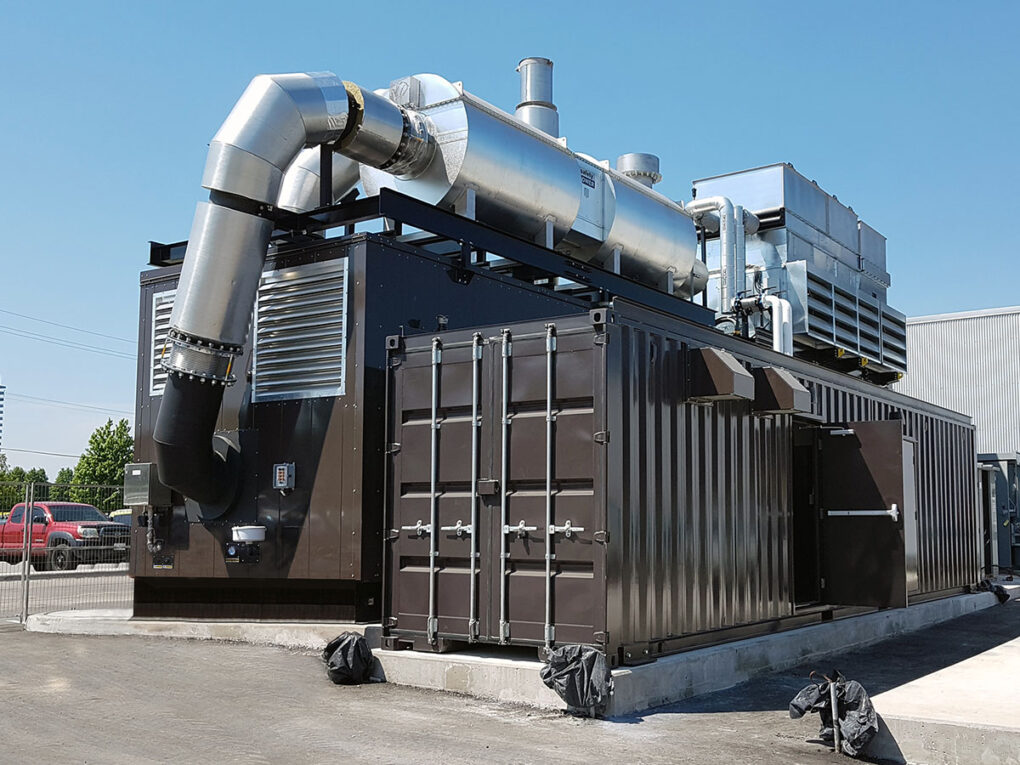Combined heat and power (CHP), also referred to as cogeneration, is the simultaneous generation of useful thermal and electrical energy from a single source of fuel. CHP systems capture the heat that would otherwise be wasted from the generation of electrical power and put it to good use. This results in much higher fuel efficiency than separate thermal and electrical generation systems. With rising energy costs and growing concerns over climate change, CHP offers a viable option to reduce energy costs and greenhouse gas emissions.
CHP systems work by capturing and utilizing heat that would normally be wasted from electricity generation. In a traditional centralized electricity generation system, fuel such as natural gas or coal is combusted to power a boiler. The boiler heats water to create steam that spins a turbine to generate electricity. Once the steam passes through the turbine, it is considered wasted energy as it exits through the smokestack as exhaust at high temperature.
In CHP, the hot exhaust steam or fluid from electricity generation is recovered to provide usable thermal energy for space or water heating, industrial processes, cooling, or other applications. Common CHP applications include heating commercial buildings or large campuses, district heating systems, greenhouses, factories, and more. By capturing this excess heat, the overall efficiency of fuel energy usage can exceed 80%, which is significantly higher than separate thermal and electricity systems that realize only around 45% efficiency.
Benefits of CHP
CHP provides numerous economic and environmental benefits over conventional separate heat and power systems. Some key advantages include:
Increased Energy Efficiency
As mentioned, CHP systems can achieve overall fuel efficiencies of over 80% by capturing heat that would otherwise go wasted. This is much higher than the estimated 45% combined efficiency of separate thermal and power generation. Greater efficiency means using less fuel to generate the same amount of energy.
Lower Energy Costs
By recovering thermal energy from power generation, CHP systems reduce the amount of natural gas, coal or other fuels needed to produce the same amount of energy. This leads to lower fuel costs over time. Estimates indicate CHP can reduce energy costs by as much as 20-30% compared to separate systems.
Reduced Emissions
The improved efficiency of CHP lowers the amount of fuel consumed and associated greenhouse gas emissions released per unit of useful energy produced. Some studies show CHP can reduce carbon dioxide (CO2) emissions by up to 50% compared to conventional generation. Lower emissions help organizations meet sustainability and climate goals.
Reliable Power
Most CHP systems have on-site fuel storage to ensure continuous operation during power outages. This provides a reliable, uninterrupted supply of electric and thermal energy critical for many commercial, institutional and industrial facilities. Backup/optional grid connection enhances reliability further.
Opportunities for District Energy
Larger CHP facilities can generate electricity and steam/hot water in centralized plants for distribution through an underground pipeline network to multiple neighboring buildings – referred to as “district energy”. This allows cities and communities to benefit from greater efficiency and lower emissions.
Types of CHP Technologies
There are several technologies available for CHP applications depending on factors like facility size, thermal and electric needs. Some of the predominant technologies include:
Gas Turbines – One of the most common Combined Heat And Power technologies, gas turbines use natural gas or other liquid fuels to power an air-compressor and combustion chamber. The hot exhaust gases spin a turbine to generate electricity while also supplying heat for use elsewhere. Sizes range from 300kW to 50MW.
Steam Turbines – Similar to gas turbines, fuel is combusted to produce high-pressure steam that powers a turbine. The steam is then piped to other locations for heating or cooling purposes. Often used for large-scale district energy systems.
Reciprocating Engines – Internal combustion engines that can run on fuels like natural gas, biogas or diesel. Engine’s shaft drives an electrical generator and exhaust heat can be captured for thermal uses. Sizes vary from 30kW to 10MW.
Fuel Cells – Electrochemical devices that combine fuel like natural gas with oxygen from the air to generate electricity with high efficiency. Fuel cell waste heat is recovered for heating or other thermal applications. Sizes limited to a few hundred kW currently.
Microturbines – A small gas-powered turbine that generates up to 250kW of electricity and captures waste heat. Used for smaller facilities requiring less than 1MW of power. Hybrid system options provide opportunity for expansion.
Absorption Chillers – Equipment that uses heat energy rather than electricity to drive air conditioning systems. Waste heat captured from CHP is sufficient to power the absorption chiller’s cooling cycle without using grid electricity.
*Note:
1. Source: Coherent Market Insights, Public sources, Desk research
2. We have leveraged AI tools to mine information and compile it

